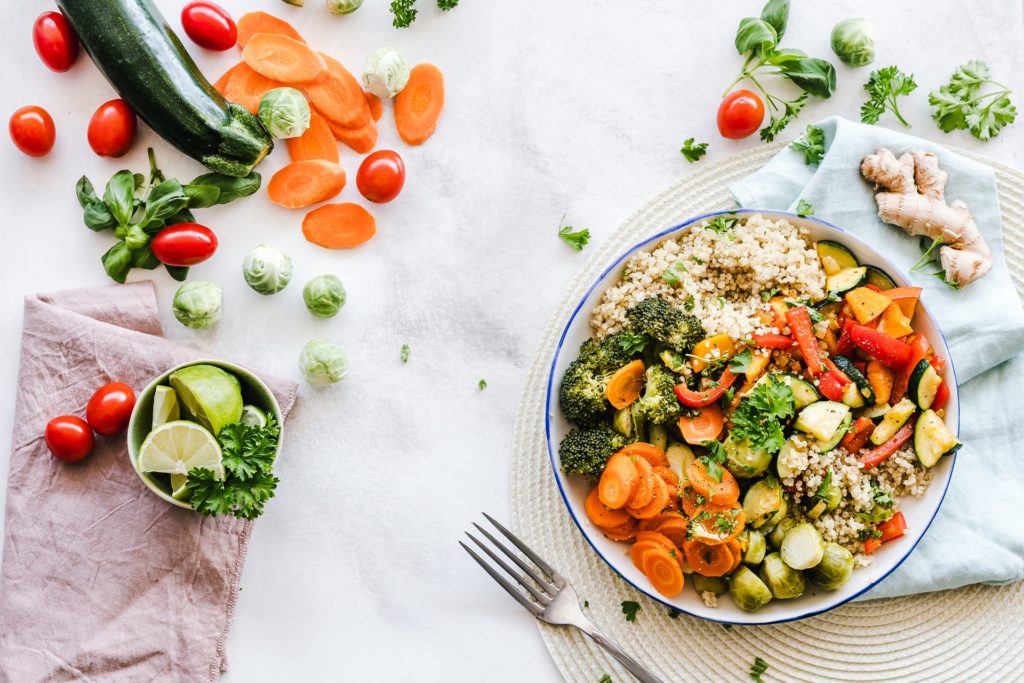
3 Ways to Get More Variety into Your Diet
Written by Michele Vieux
You make gains in the gym because you push your body with “constantly varied”, functional movement and your nutrition should be no different.
If you eat the same thing every single day, especially if it doesn’t include the full spectrum of colors, you are certainly missing out on at least a few, key nutrients which is detrimental to your health, but can also cause crazy cravings because your body isn’t satisfied. So besides not being as healthy as you can be, now you’re likely overeating too. Or you’re spending too much on supplements to make up for the lack of nutrients you’re not consuming naturally.
For some, just thinking about eating a variety causes stress, whether it be because of your taste buds or busy schedule. But it doesn’t have too be difficult! Here are some ideas of how you can get more variety into your diet.
How to Get More Variety into Your Diet
Eat a Rainbow
This is a pretty well-known recommendation and is a great visual way to make sure you are getting all of your nutrients and the variety your body craves and needs. Eating a wide variety of heathy foods (such as lean protein, vegetables, fruits, and complex carbs) helps protect against diseases by providing your body with the different nutrients – vitamins and minerals – it requires.
This can also be a fun game to play with the kids! How many different colors can you add to your plate? And to your day? Try to get at least one serving of each color in the rainbow of fruit or vegetable each day. To do this, make sure you have your rainbow shopping list and cross things off when you put them in your basket. Bonus points if you GROW these yourself! Kids love to learn about how food grows and help take care of the plants. They are more likely to be curious and willing to try what they grow too. Here are some examples of colorful fruits and veggies to try:
Red Fruits & Vegetables
red bell peppers, raspberries, strawberries, rhubarb, radishes, red tomatoes, red grapes, apples, cherries, pomegranate, watermelon, grapefruit
Orange Fruits & Vegetables
orange bell peppers, oranges, carrots, butternut squash, orange tomatoes, yams, papaya, pumpkin, peaches, apricots, nectarines
Yellow Fruits & Vegetables
yellow bell peppers, acorn squash, spaghetti squash, yellow beets, yellow tomatoes, bananas, pineapple, lemons, starfruit, mango, apples, pomelo, grapefruit, pears
Green Fruits & Vegetables
green bell peppers, spinach, kale, zucchini, cucumbers, lettuces, broccoli, Brussels sprouts, green beans, chayote, celery, parsley, cilantro, cabbage, microgreens, sprouts, green grapes, kiwi, avocado, apples, peas
Blue/Purple Fruits & Vegetables
blueberries, beets, purple grapes, plums, figs, eggplant, red cabbage, purple cauliflower, purple potatoes, blackberries
Shop at the Farmers Market
Whether you’re looking for produce, fresh meat and seafood, eggs, specialty foods, health and beauty products, crafts, flowers or food trucks – there’s no better place to shop than the farmers market! Besides getting the freshest and best deals around, you’re supporting local farmers and craftsmen. Basically, you’re a sustainable-eating ninja!
Sustainable eating is good for you, and pretty much everyone involved in the process, as well as the environment and economy. The practices used in the farming process are safe for workers and consumers – i.e. no unfair conditions for workers and no pesticides and other chemicals are used, plus the animals are treated humanely. It encourages and supports local farmers and keeps jobs in your area.
Another MAJOR benefit of shopping at your local farmers market is that you can ask the farmer questions so you can learn about how your product was grown/raised and how to best use it. They have great tips for preparation, preservation and consumption of their goods and can recommend new food for you to try that you might not normally pick out on your own. Plus everything tastes better when it is super fresh and you know where it came from.
Try New Recipes
At least once a week, try a new recipe! They don’t have to be Iron Chef level, just something you haven’t tried before. Here are a couple of ways to execute this.
If you’re not feeing super creative in coming up with your own recipes, you can follow a couple of recipe blogs – there are a ton out there to choose from that can fit any lifestyle or diet. You can also search for recipes on this blog – we have so many from over the years that have been shared by our coaches and community.
If you’re a seasoned cook, then ‘steal’ recipe ideas from others – whether they be from eating out with friends or dinner parties at their houses (but not from the fridge at work). Some people have the knack for being able to try new dishes then come up with a similar version of their own without a recipe. If you’re not that skilled, ASK for the recipe. Seventy-five percent of the time, the chef/cook will be willing to share it, or at least some version of it.
Let’s help each other get started! What is your favorite recipe that uses a variety of colors? Share in the comments so we can all enjoy eating a rainbow!
Colorful recipes to try…
For more nutrition advice and recipe ideas, join our online Nutrition Coaching Program a personalized nutrition plan, accountability, and the education to maintain life-long healthy habits. We work with all people – from athletes who need precise macro-based nutrition plans to achieve their competitive goals, to people who just want to improve body composition and be healthier.

Thank you very much for sharing such a useful article
Thank you very much i really like it
healthy foods promotes good health and protects against chronic illness. Eating a healthy, well-balanced diet means eating a variety of foods in the recommended amounts from each of the five food gro https://get-tubemate.in https://get-mobdro.com https://authorityapk.com
asdfa
Thank you very much for sharing such a useful article.